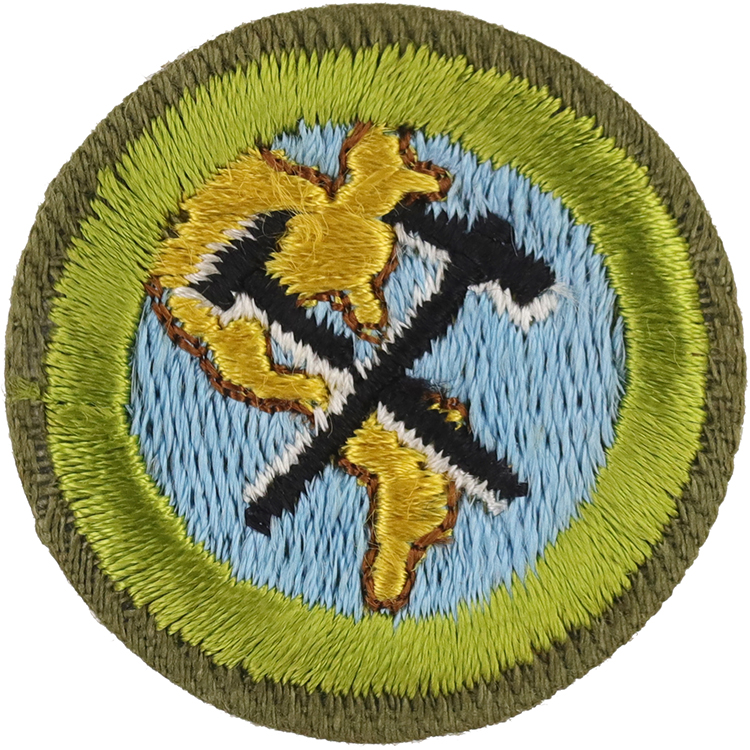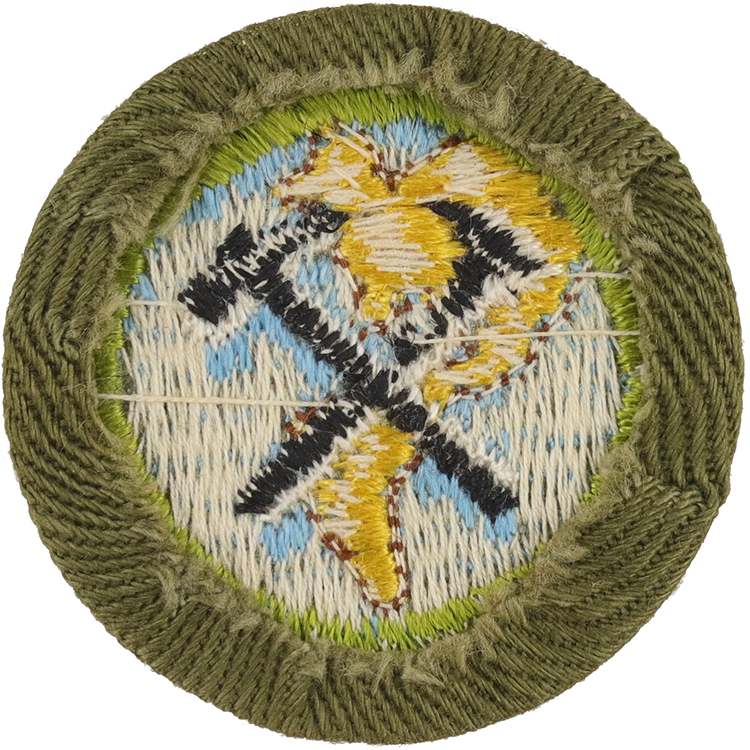
Fig. 1: Geolog-E2-Front
- Cloth: Khaki right twill
- Embroidery: Cotton lock stitch

Fig. 2: Geolog-E2-Reverse
- Back: Plain NO imprint with starch
Item Name: Geology 1953 - 1960
Item ID: Geolog-E2
Collector Rating: 1
Requirements June 1953 until January 1957
1. Make one of the following collections:
- Collection of at least 12 ores, with the name, the composition and the metals commonly produced from each ore. Tell how each metal, obtained from these ores, is used in our modern civilization.
- A collection of at least 15 rock-forming minerals, with the name and the more important varieties of each and the more important rocks, in which it is commonly found. Tell how the minerals, or the products derived from them, are used in our modern civilization.
- A collection of at least 18 common sedimentary, igneous, and metamorphic rocks and name of the important minerals found in each. What useful products are made from these rocks?
- A collection of at least 20 different fossils, with the names of each and the geologic formation in which it was found. Explain how fossils are used to tell the age of sedimentary rocks and how this knowledge is used in finding mineral deposits.
2. Visit one of the following commercial operations with the foreman or someone in charge, or with your Merit Badge Counselor, and discuss how the deposit was formed; how it was found; how it is being developed and why; its probable life; the current price of the product, and the safety precautions that have been taken for the safety of workers and the public:
(a) A mine; (b) An oil or gas field; (c) A quarry; (d) A gravel pit or clay pit or shell pit.
3. Make a sketch map of an area at least one mile square, using a compass, showing streams, roads, and the elevations of important points and locations and character of all rock outcrops.
4. Do one of the following:
- Assist a geologist in mapping an area.
- Make a structure contour map from data obtained from surface mapping and diamond core, or other type of core drilling or oil well drilling.
- Examine the air-photos of an area and discuss the major land features; why they are as they are; the reasons for and the meaning of the vegetational pattern, and what can be inferred about the possible use of the land or the possible presence of mineral deposits.
- Visit an area where enough rocks are exposed to permit you to point out the different types of rock influence; the topography; type of soil; dominant vegetation; use of the land; and discuss how land forms, soils, and vegetation may indicate the character of the underlying rocks.
- A project of similar character chosen by the Merit Badge Counselor to utilize the geological characteristics of the area in which you live, or an area with which you are familiar.
Requirements January 1957 until June 1972
1. Do one: (a) Make a collection of different ores, rock-forming minerals, and fossils and label with name and use (or age) of each specimen. (Minimum total twenty specimens.) (b) Make a collection of different sedimentary, igneous, and metamorphic rocks and name the important minerals found in each. Tell what use can be made of these rocks? Minimum total, ten (specimens).
2. Do one: (a) Visit a mine; quarry; oil or gas field; a gravel, clay, sand, or shell pit; or other similar operation. Explain the nature of the deposit and how the product is removed, transported, sold, and used. What safety precautions are used in this operation? (b) Visit your local water supply system and describe the source, quality, and amount of water required for your community and its relation to the geology of your area.
3. Find out if there is a topographic map of your home area and how it is obtained. Study the map, explaining the important geological features shown on it. (If a local map is not available, study one of another area that is familiar to you. Air photos may be used instead of a topographic map.)
4. Do one: (a) Prepare a report including maps or sketches on the geological features on or below the surface of the region where you live, your Scout camp, or an area that you know. (b) Describe how the soil of your area was formed and the kinds of rock from which it came. (c) Describe the earth materials used in your home (or a public building) and tell how they were obtained; or list those which you use every day and give their source.
ALTERNATIVE: In place of 4a, 4b, or 4c, the Merit Badge Counselor may choose a project of like merit, that will make use of some of the interesting geological features of the area in which you live.


